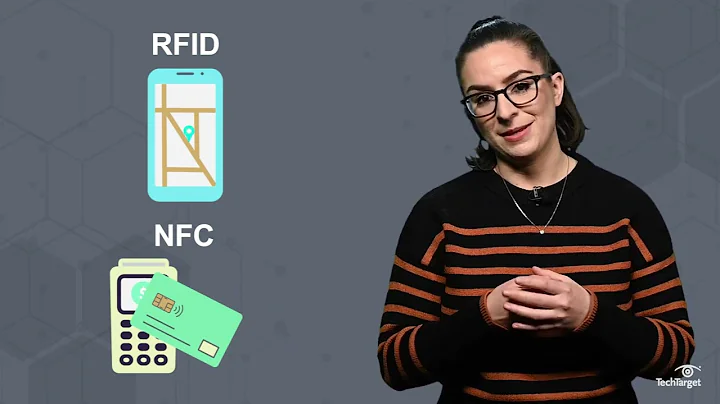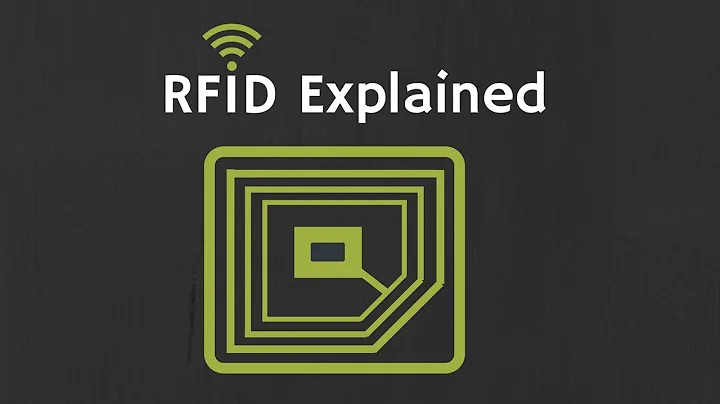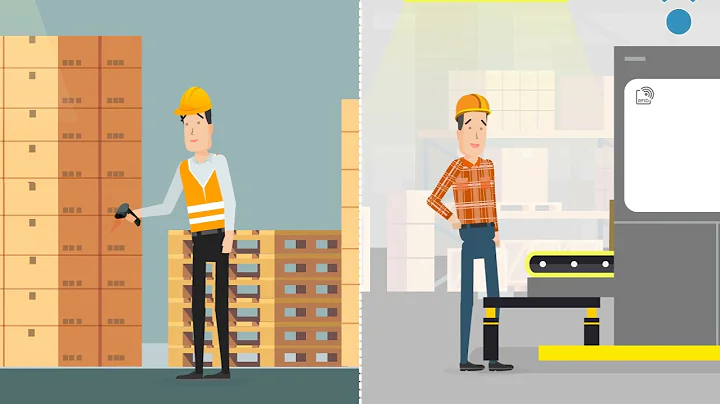RFID and NFC are both short-distance IoT communication technologies. Since the former uses multiple frequency bands and the latter was developed for the mobile market, the development and application fields of the two are also different. RFID focuses on radio frequency identification and can be applied to the identification of items. Nowadays RFID has been widely used in all walks of life; NFC focuses on near field communication and is used with mobile devices to achieve mobile payment applications. Next, learn more about the technology and applications of RFID and NFC.

RFID was first used in identification of friend or foe, and then more applications were developed.
RFID (Radio Frequency IDentification; Radio Frequency Identification) uses wireless radio frequency technology as an application for label identification. It was first developed during World War II (1935-1950) and was first used by the British Air Force in the field of aviation safety.

The internal structure of passive RFID tags
They developed an IFF (Identify Friend of Foe; Identification Friend or Foe) system at that time, and installed Active tags on each aircraft. When the ground radar transmits and detects the signal, When an aircraft is deployed, the tag on the aircraft will also send out a timely response to identify whether the aircraft is an enemy or a friend and prevent friendly military aircraft from being accidentally hit.
In the 1960s, many papers related to radar and RF were published, and many companies began to commercialize and popularize RFID technology. RFID was first used in the anti-theft mechanism of goods. This technology is still widely used today: merchants install a set of passive tags in product packaging, which only have 1 bit of data (representing on or off). When the product has When paying, the bit will be turned off at checkout. If there is no payment, when the person tries to take the product out of the store, the reader at the door of the store will detect it and sound a loud alarm.
Until 1973, Mario Cardullo was the first to apply for a US patent. His active RFID tag had a rewritable memory and could be used repeatedly, becoming the originator of today's RFID. In the same year, Charles Walton also obtained a patent for passive RFID in the United States, which was applied to door lock products: a transponder is installed on a door card. When the reader on the door lock detects the correct door card, the lock will be unlocked. Today, this technology is widely used in door locks in hotels and residences.
RFID improves warehousing and logistics efficiency and makes ticketing more convenient.
Thanks to the technological advancement of the Internet of Things, RFID has been developed to this day, and has become thin, lightweight, and can provide one-to-many reading, can be reused, and has high storage capacity. Battery-free design, long service life and high safety. It is contact-free and can be sensed and read within a certain distance. It can resist various harsh environments, has high ductility, and can be made into various packaging types. Therefore, RFID tags were first widely used in the automation fields of warehousing and logistics. By 2005, with the large-scale adoption by department store retailers, the rapid popularity of RFID in the market was accelerated.
Today, RFID has a wide range of applications. In addition to retail channels, it now includes logistics and warehousing, national defense and security, public areas, medical care, tourism and leisure, financial services, telecommunications services, transportation, construction industry, exhibition venues, company access control, There are application cases for RFID introduction in school security and so on. Common ones include access control systems, goods management, asset recovery, material management, waste disposal, medical applications, highway toll systems, commodity anti-theft and anti-counterfeiting, automation control, various tickets, animal identification, dementia prevention and loss prevention, etc.
RFID technology and principles
RFID products are mainly divided into: Tag (tag) and Reader (reader or interrogator). Tags can be divided into Passive (passive), Semi-Active (semi-active), and Active (active) types according to design. What these tags have in common is that there is a microchip inside with a small amount of memory (mainly storing identification information), a radio wave transceiver (Transceiver) and an antenna.
uses a point-to-point communication method. When the Tag is close to the Reader, it will receive the query command and electromagnetic wave sent by the Reader, allowing the internal chip of the Tag to conduct electricity and operate, giving it enough weak power. To transmit various information of the Tag (such as material number, production date, product barcode, door number, car number, etc.) back to the Reader, and then the data can be transmitted to the background computer for subsequent identification and processing. . The
Passive tag needs to receive enough Reader electromagnetic waves to have enough power to drive its internal operation, so the response and access speed are slower and the distance needs to be closer. The Semi-Active tag adds a small battery, which can still transmit information back even under weak Reader signals, so it has the characteristics of good response, fast speed and longer distance.
Active tags are equipped with a power supply or a large-capacity battery. They can use their own power to form an effective active area around them, and actively detect whether there are readers around them in order to send ID information there.
As for the frequency band and types used by RFID, there are 6 types: LF (low frequency, used in animal identification and factory data collection), HF (high frequency, usually designed into cards, such as MIFARE, ISO/IEC 14443 specification, Used in products such as bus cards, and also a frequency band for NFC applications), UHF (Ultra high frequency, with active tags, used in the national defense field), European and North American UHF frequencies in the ISM band (used in EAN European product codes, and various specifications), microwave in the ISM band (that is, the standard for 802.11 WLAN and Bluetooth ), microwave in the ultra-wideband (UWB, with semi-active or active tags) band. The speed ranges from low speed, medium speed to high speed, and the distance ranges from 10 centimeters to up to 200 meters.
NFC evolved from RFID to attack the mobile device market
NFC (Near-Field Communication; near field communication) technology evolved from RFID technology. It was jointly developed by NXP ( NXP ), Nokia and Sony and is based on RFID. An interconnection technology that has passed international standards such as ISO/IEC IS 18092, EMCA-340, ETSI TS 102 190, etc., becoming another derivative technology of RFID, specializing in the mobile device market. Three integrated applications of

NFC chip in the field of mobile payment
NFC uses the HF (high frequency, 13.56MHz) frequency band, allowing two devices to operate at 3 transmission speed modes of 106Kbps, 212Kbps, and 424Kbps within a distance of 20 centimeters. Information exchange. NFC is a device authentication technology similar to Bluetooth, except that Bluetooth requires devices to be "paired" before they can communicate with each other, while NFC does not, as long as the device is in close proximity. Therefore, NFC can also be used as a complement to Bluetooth technology to accelerate mutual authentication between devices.
NFC targets the mobile device market, which is currently dominated by smartphones. Through the built-in NFC chip, many RFID related applications can be achieved. NFC has 3 modes: card emulation mode (similar to replacing EasyCard), reader mode (can actively read information provided by other devices), and point-to-point mode (can be used for data transmission between devices), which can be applied to Employee identification card, clock in and out, access control management, electronic tickets, membership card collection points, computer security login, public transportation tickets, electronic payment and other fields.
Big ICT manufacturers are the first to support it, and the financial industry is also optimistic about NFC technology.
Although NFC debuted in 2004, its development was restricted due to the fact that electronic payment and related laws had not yet become a reality at that time. However, with the promotion of many major NFC manufacturers and the support of major ICT manufacturers and software giants, the recent development of NFC has begun to show signs of success.
Google supports NFC function in Android 4.0 version, and Microsoft has also added NFC support function to its Windows Phone 8 and Windows 8. This will allow Android phones/tablets or WP8 phones/Windows 8 tablets with built-in NFC chips to After being authenticated by NFC, the Bluetooth function can be turned on between computers/laptops to transfer URLs, Google/Bing map information, contacts (vCard) and pictures to each other. The S Beam launched by Samsung is built into its own mobile phones. After NFC certification, it turns on the Wi-Fi Direct function for high-speed transmission to transfer large-capacity music, video and other files. NFC can assist mobile phones, making data sharing easier, without the need for complicated settings.
Android's NFC mobile phone can be divided into three types according to its SE (Secure Element; security component) configuration method: built-in mobile phone, built-in SWP SIM card, built-in SD card. In order to uniformly manage NFC card issues, the GSMA Alliance defined the TSM (Trusted Service Management; Trusted Service Management) platform to meet the operational integration needs of mobile payment providers.
On the Apple side, its iPhone 6/6 Plus phones also have built-in NFC chips, which are first used in Apple Pay mobile payments. With its Touch ID (fingerprint recognition) and NFC technology, consumers can check out at more than 22,000 online or physical stores in the United States that support Apple Pay without taking out a credit card or signing. The service will also be extended to Apple Watch smart watch. Therefore, the popularity of NFC will change consumption habits.





















